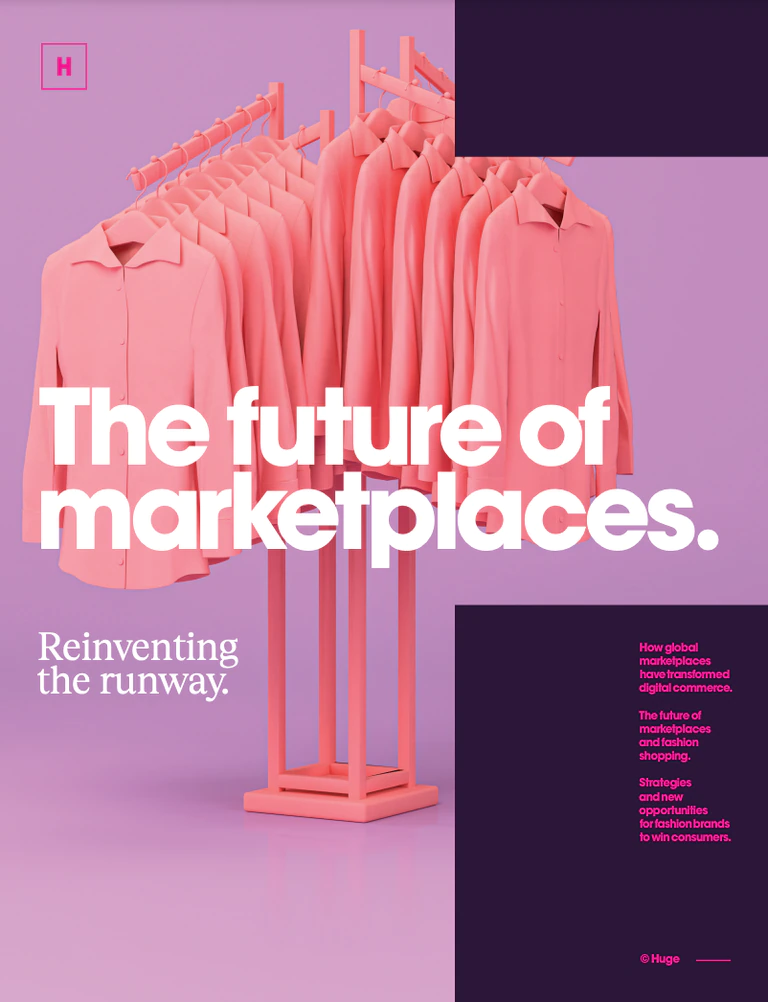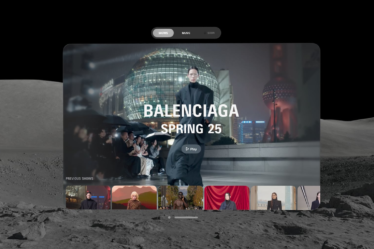
From digital platforms and experience design to physical retail, to personalisation, loyalty strategies and social commerce, companies as varied as LVMH, Kering, P&G, McDonald’s and Spotify work with growth acceleration company Huge.
Recently, Huge released its “Future of Marketplaces” research forecast on the evolution of the marketplace model. “Marketplace platforms of tomorrow will bear little resemblance to the legacy experience of a digital marketplace as just one big product catalogue,” says Holden Bale, global head of commerce at Huge, who recently debuted the research at Shoptalk US 2022. “Much of the innovation we’re seeing in commerce is happening on marketplaces, and brands must seriously consider the role of marketplaces in their commercial and customer engagement strategies.”
“Search and social are becoming shoppable marketplaces themselves,” adds co-author Kim Nguyen, head of distributed commerce at Huge. “With new contenders like NTWRK and Depop, brands who write off marketplaces will quickly lose share of wallet for the covetable Gen-Z consumer.”
It is a timely investigation into the role of marketplaces in the fashion industry. The pandemic refocused the role of the marketplace, which offers brands exposure and another key channel of distribution without the pains of traditional wholesale. Now, new drivers across customer experience and business innovation are becoming catalysts for further innovation.
From advancements in retail media networks and storytelling capabilities, to operational efficiencies that provide great service and gateways into the metaverse, marketplaces stand to be an increasingly strategic partner to fashion brands across the full value chain.
Below, BoF shares extracts from the Huge report, distilling four distinct marketplace trends that will define future success in the space.
The New Face of Advertising: Commerce-Infused Marketing and Retail Media Networks
BoF: The number of people who make at least one purchase on a social channel during the calendar year is expected to be 50 percent higher in 2022 than it was in 2019, reaching 96 million customers in the US alone, according to BoF and McKinsey’s State of Fashion 2022 report. As customers become increasingly comfortable with shoppable media and social commerce functionality, natively shoppable advertising will ease friction for brands and consumers alike.
Retail media – paid advertising on platforms with transactional e-commerce capabilities, like retailer websites – has become a formidable advertising avenue. An increasingly popular way for retailers to monetise their own traffic, retail media networks have become even more attractive in light of cookie restrictions, as marketers seek opportunities to advertise on platforms with first-party behavioural data and the programmatic tools that enable high-quality targeting. The market itself is growing rapidly, reaching $77 billion in 2021.
Marketplaces today are going well beyond “traditional” retail media — the most common forms of which are sponsored search results and display ads, similar to the core advertising products of search and social platforms. What distinguishes leading marketplaces, including Tmall, Mercado Libre, Rakuten and Amazon, are the breadth of their advertising offerings.
Indeed, Amazon alone reported $31 billion in advertising revenue for 2021, larger than YouTube’s advertising business and on par with the combined advertising dollars for the entire global newspaper industry. They are actively experimenting with shoppable video and live-streaming, and already provide novel marketing opportunities. For example, Amazon Fashion’s sub-property The Drop collaborated with New Balance in 2021, and brands like Nintendo advertise on delivery boxes.
For many marketplaces, selling digital advertising inventory is often far more profitable than selling goods, with margins frequently over 50 percent. While department store retailers have always offered co-op advertising opportunities, they have been similar to the print advertising process, with upfront negotiations, long lead times and limited placements. Marketplaces, however, are focused on seller enablement and self-service, providing advertisers with programmatic tools to buy and run more targeted inventory.
Key Considerations
Over the medium term, Huge predicts that marketplace advertising networks will offer three times more advertising options than traditional retail media. In time, it forecasts all digital advertising to be natively shoppable.
Brand Experience Hubs: Rich Merchandising and Story-Selling
BoF: New marketplace operations promise to protect brand equity and offer brands more autonomy over their visual identity to support storytelling and user experience. Amazon’s Luxury Stores marketplace is working to emulate the success of Alibaba’s Tmall Luxury Pavilion via a glossy in-app section where brands can create their own distinct digital storefronts. Its concession-style model allows brands to control inventory and pricing that affect the look and feel of their digital storefronts — a long-standing concern for brand-conscious labels wary of tarnishing their image by allowing Amazon control.
While social media enabled brands to engage with consumers, most third-party platforms — search, social, marketplaces — historically restricted brand innovation and merchandising. Products were listed within the bounded context of an Amazon or Zalando product page template, while branded content could be hindered by the inconsistent native capabilities of each platform. These limitations and disparities in brand experience across platforms could reflect poorly on that brand, posing brand equity and perception risks.
Today, marketplace giants are reducing limitations and allowing brands to have more control over their front-end presentation layer. Rakuten Fashion in Japan and China’s Tmall both allow brands to write their own code and create their own templates, while platforms like WeChat have allowed near complete freedom in design and development through their mini-programmes.
Each of those platforms allow for direct brand-to-consumer engagement, including live-streamed content and direct messaging. Now, unless brands are investing a great deal in a differentiated website or app experience — or have a unique value proposition, like a private community or a unique loyalty programme — the aesthetic difference between a marketplace brand hub and a brand’s own website or app can be barely perceptible.
Brands can also use marketplaces to test new trends and technologies, and prioritise investment for their own digital platforms. Experimenting in real-time with different cross-selling or “shop the look” narratives on Instagram, testing the value proposition of an augmented reality experience in Snap, deploying variants of influencer content on Pinterest, or measuring the outcome of different livestreaming strategies on WeChat can lead to insights that determine longer-term DTC initiatives.
Key Considerations
Huge forecasts that by 2024 three quarters of the world’s top social content creators and influencers will have their own shoppable stores built on top of marketplaces, or will be feeding content directly into marketplaces, with social shopping (consumers picking products for each other) and guided selling (brands providing 1:1 guidance to the right product for consumers) making up 15 percent of marketplace revenue.
Commerce as a Service: End-To-End Enablement
BoF: In recent years, a number of marketplaces have built cohesive models for bringing labels to market, offering critical operational support while allowing designers to focus on the creative elements of the business. Some take financial stakes in partner labels and others simply take a commission on sales. Among the buzziest are brand accelerator Tomorrow, Slam Jam and Farfetch’s New Guards Group, which launched and scaled Virgil Abloh’s Off-White — but the commercial opportunity for major players is increasingly significant.
The operational arms of many global marketplaces can power everything from international expansion and same day delivery in markets where a brand has no formal business presence, to complete in-store technology solutions, payments, fraud and tax management. In many cases, the largest marketplaces have come to operate the most sophisticated supply chains and logistics networks in the world. This emphasis on providing end-to-end commerce capabilities — offering “commerce as a service” to brands — is evolving into standalone businesses for marketplaces. Just like advertising, brands need not sell on the marketplace itself to avail themselves of many valuable marketplace offerings.
Increasingly, Amazon is offering their supply chain network without a requirement to sell on Amazon itself through their Multi-Channel Fulfilment (MCF) product, effectively white-labelling their fulfilment services to provide direct competition to third-party logistics providers. While this can be costly for brands, they are granted access to a distribution centre network, and ground and air fleets that rival the world’s largest logistics providers.
Huge forecasts that, in 5 years’ time, up to 25 percent of large multi-brand retailers will commercialise their own delivery infrastructure to sell to other brands.
In Japan, Rakuten offers full cross-border logistics services to brands, including for products sold outside of Rakuten’s Japanese e-commerce marketplace. Mercado Libre, with a strong footprint in Mexico, Brazil, Chile and Colombia, provides many of the same options for brands, including financial operations: payment conversion and currency exchange; cross-border tax calculations at reduced fees; and managing customs and duty requirements. In many cases, there are unseen benefits — Tmall, Mercado Libre and Zalando partially subsidise expedited fulfilment for all the brands on their platform at bulk rate costs.
Alibaba and Amazon both offer nearly complete in-store technology solutions. Amazon’s “Just Walk Out” technology has started to be licensed by brands ranging from Starbucks to airport retailer Hudson, while Alibaba offers in-store inventory management and checkout solutions for small and medium-sized businesses, and has an entire business line dedicated to in-store technology solutions for grocers.
Key Considerations
All social and search platforms with a commerce element will soon have an end-to-end supply chain and payment offering for brands, either in partnership or owned and operated internally, while Huge forecasts that, in 5 years’ time, up to 25 percent of large multi-brand retailers will commercialise their own delivery infrastructure to sell to other brands.
Gateway to the Metaverse: The Virtualisation of Products and Places
BoF: The Opportunity in Digital Fashion and Avatars, a BoF Insights report, charted the surge in popularity of non-fungible tokens (NFTs) in 2021. Indeed, sales reached approximately $10.7 billion in Q3 2021, more than eight times the volume of the previous quarter. While the token standard for NFTs emerged in 2018, they only gained speed beyond niche communities in 2020 and truly accelerated in 2021 for a variety of reasons, but particularly attributed to increasingly sophisticated NFT marketplaces that allow for authentic collaboration and for commercial routes-to-market.
New marketplaces centred around the sale of fully virtual goods like DressX and The Dematerialised are using the marketplace model — the multi-sided connection of buyers and sellers — to create a new category of fashion products and how we shop for them.
From Adidas partnering with Bored Ape Yacht Club to Dolce & Gabbana working with UNXD, the appetite for fashion brands to explore the promises of virtualisation, decentralised technology, NFTs, and all things connected to Web 3.0, is vast. While marketplaces focused on the sale of virtual goods seem niche today, traditional marketplaces are already evolving to reflect this growing trend — NFTs have quickly become a more than $25 billion market.
Alibaba has also supported numerous successful NFT drops with Alipay, while Tmall held a Singles’ Day NFT art exhibition with brands including Burberry, Coach and Longines, and their Luxury Pavilion launched the world’s first live authenticity tracing function based on blockchain technology to help address grey market concerns. Rakuten allows consumers to use their Bitcoin and other cryptocurrencies to shop at Rakuten Pay and Rakuten Point Card-affiliated businesses across Japan, including at 7-Eleven stores and McDonald’s.
For further innovation, we expect to see full marketplace experiences inside of virtual worlds, such as a marketplace creating a virtual department store, allowing brands a space for store-in-store boutiques. “Commerce as a service” marketplace offerings will also expand to include securing and processing transactions in virtual worlds, providing tools to mint NFTs and manage a virtual product catalogue, and services to render products into 3D.
Key Considerations
Huge predicts that 70 percent of marketplaces will accept virtual currencies natively at checkout by 2025, while all marketplace giants will offer services for brands to develop, merchandise and sell virtual products over the medium term.
This is a sponsored feature paid for by Huge as part of a BoF partnership.



